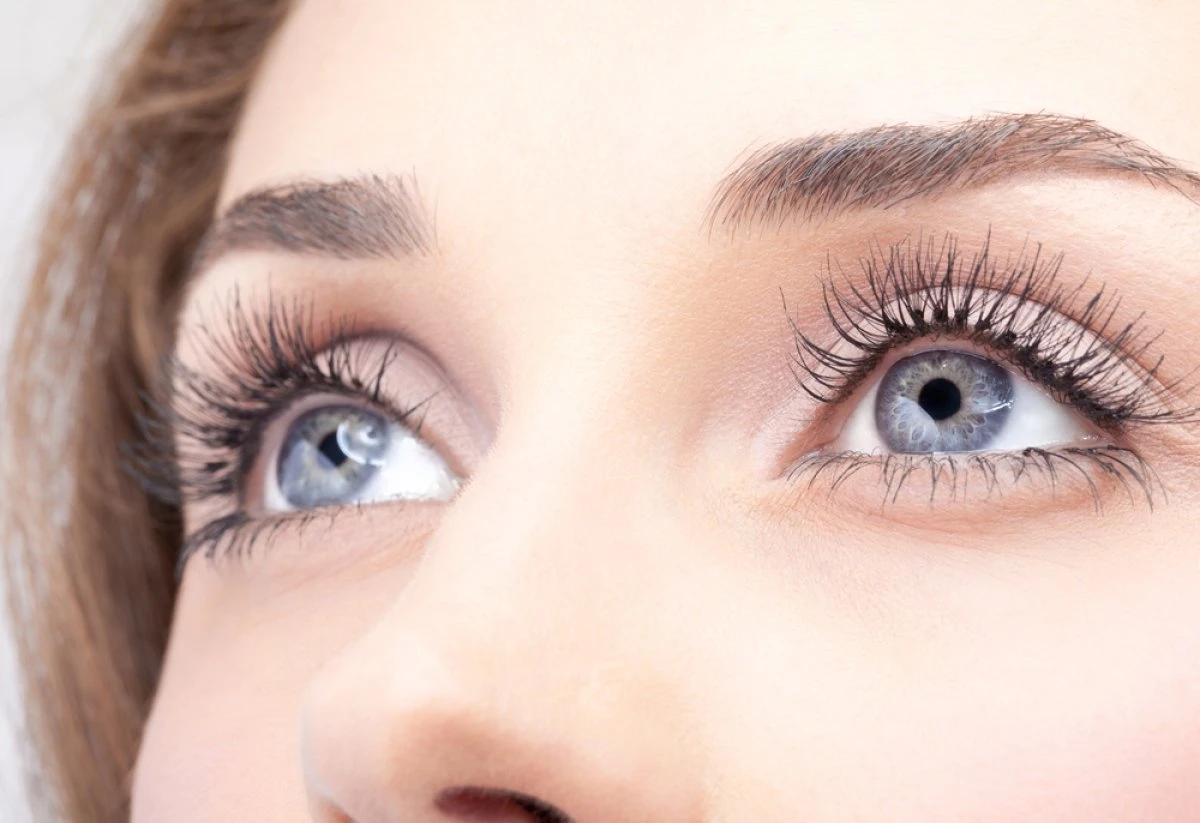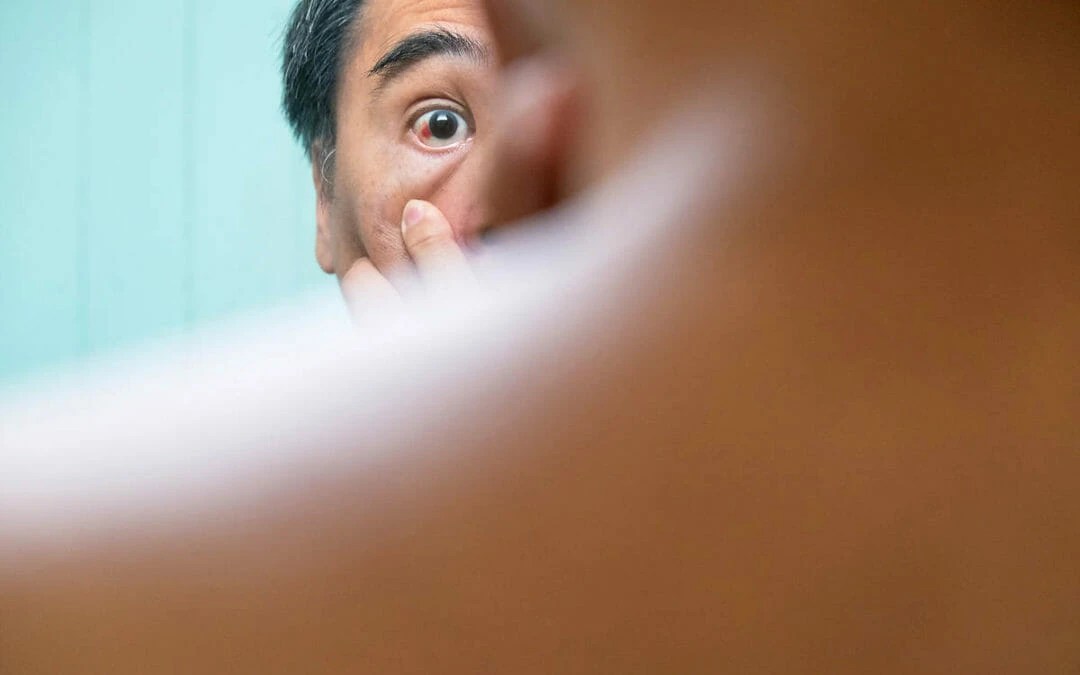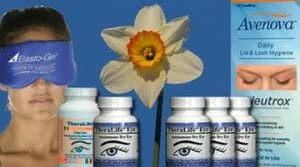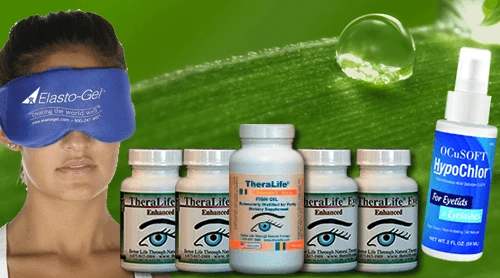Treat Dry Eyes to Treat Ocular Rosacea-
Try oral dry eye treatment to achieve more sustainable relief all the day long. Reduce inflammation and treat ocular rosaceaCustomer Stories- Treat Ocular Rosacea
Customer Stories
Severe Chronic Dry Eyes- ocular rosacea
I have had chronic severe dry eyes for many years I am writing to let you know how thankful I am for your product- TheraLife Eye. It has virtually changed my life. Instead of ALWAYS thinking about my sore, red, dry eyes, I NEVER think about them anymore. And every time I look in the mirror and see my bright, wide, youthful looking eyes I make a little wish that your company is thriving and I will never again have to be without TheraLife Eye capsules. You know, when your eyes are red and you squint in discomfort, you really do look older.
Thank you, thank you, thank you. C.L. Ohio, United States
Introduction
People with facial Rosacea often have ocular Rosacea, which causes chronic dry eyes, blepharitis, meibomian gland dysfunction (MGD), chalazion, styes, glaucoma, and conjunctivitis. In other words, facial Rosacea leads to various eye disorders – left untreated; it can threaten vision. Therefore, the skin disorder Rosacea can lead to all kinds of complicated eye problems.
Facial Rosacea is considered an autoimmune disorder.
More than 10% of the general population exhibits dermatologic characteristics of Rosacea; of these, up to 60% experience ocular complications. An epidemiological study in Sweden showed a 10% prevalence of Rosacea.
Experts estimate that around 5% of people worldwide have some form of Rosacea. However, many people with mild symptoms never have their Rosacea diagnosed. People tend to assume symptoms of ocular Rosacea are issues like seasonal allergies or problems with their contact lenses.
Incidences of Ocular Rosacea- Treat Ocular Rosacea
Found to affect up to 60 percent of rosacea patients in surveys by the National Rosacea Society (NRS), ocular Rosacea often results in a watery or bloodshot appearance, irritation, and burning or stinging of the eyes. In addition, the eyelids may become swollen, and styes are common. Many patients report feeling a gritty sensation as if there’s a foreign body in their eyes. Blasts of cold air in winter may also cause a watery discharge, another possible symptom.
Although as many as 58 percent of rosacea patients have ocular symptoms in clinical studies, it allows treatment and control if diagnosed before it becomes severe.
Comorbidity
A medical study of ocular rosacea patients found that 85 percent had meibomian gland dysfunction (MGD). The meibomian glands line the edge of the eyelid and secrete a fatty substance that helps keep the eye from drying out. Plugging of these glands may result in dry eye, styes, or chalazion (a benign cyst).
Since most people do not associate eye discomfort with a skin disorder and the symptoms are usually mild, many rosacea patients may not recognize that they suffer from the ocular as well as the facial manifestations of the disease. Severe ocular Rosacea, however, can pose significant consequences if left untreated, including corneal damage and the development of additional blood vessels in the cornea, a condition known as corneal neovascularization. Both conditions may result in reduced visual acuity.
A research study examines the ocular comorbidities of Rosacea in Koreans. We discovered a high burden of ocular comorbidity where more of the individuals with Rosacea had blepharitis, chalazion, glaucoma, dry eye syndrome, and conjunctivitis.
About 20 percent of rosacea patients develop ocular Rosacea before the facial symptoms appear, and ocular rosacea patients are then often referred to dermatologists by their eye doctors.
The exact cause of ocular Rosacea, like skin rosacea, is unknown. It may be due to one or more factors, including Heredity. Environmental factors
What is Ocular Rosacea?
Ocular Rosacea is a chronic inflammatory condition that affects the eyes and surrounding tissues and has redness, irritation, itching, burning sensations, and dry eye symptoms. In some cases, it can also lead to complications such as corneal ulcers or scarring of the eyelids.
This comprehensive guide aims to provide an overview of effective treatments for ocular Rosacea. The focus will cover topical medications, oral antibiotics, lifestyle modifications, and non-pharmacological approaches. Next, we discuss strategies to manage long-term treatment plans to reduce recurrence and improve quality of life.
This article aims to teach readers how to treat ocular Rosacea and its associated symptoms.
Overview Of Ocular Rosacea – Treat Ocular Rosacea
Ocular Rosacea can cause or exacerbate Meibomian gland dysfunction, leading to worsened symptoms of dry eye disease. Your eye doctor can identify signs of ocular Rosacea by evaluating the front of the eye during a comprehensive eye examination.
What is the relationship between Rosacea and dry eye?
Swollen eyelids, bloodshot eyes, or a feeling that you have something in your eyes could mean that you have Rosacea in your eyes. People who have Rosacea are often unaware that it can also develop in their eyes. As a result, symptoms, such as irritated or dry eyes, are often overlooked.
Ocular Rosacea is a common and potentially disabling facial skin condition affecting many individuals.
Ocular Rosacea has been found to cause significant visual impairment and can lead to permanent damage if left untreated; thus, early diagnosis and treatment are essential for successful management.
The primary symptoms associated with ocular Rosacea include inflammation of eyelids and conjunctiva, redness in the whites of eyes (known as an episcleral injection), itching or burning sensations, dry eye syndrome, recurrent styes or chalazia, blurred vision, photophobia (light sensitivity) and tearing due to irritation.
Diagnosis of ocular Rosacea often relies on observation of clinical signs combined with patient history taking.
Regular eye hygiene practices are vital. Bacteria and debris that accumulate around the eye area may worsen their symptoms.
Numerous topical medications have effectively controlled some of the most bothersome signs and symptoms related to ocular Rosacea for those seeking relief beyond good hygienic practices.
Depending on its severity, many practitioners suggest integrating these topicals into a specific regimen for each case.
What triggers ocular Rosacea?
Intense sunlight, wind, or temperature. Some emotions, such as anger, stress, or embarrassment. Certain drugs, such as cortisone creams.
Topical Medications – Treat Ocular Rosacea
Ocular Rosacea is a chronic condition that affects the eyes, causing redness and irritation—treating ocular Rosacea for individual patients based on their symptoms and overall health.
One effective way to treat ocular Rosacea is through topical medications:
* Skin care products containing ingredients such as green tea extract or chamomile can help reduce inflammation and soothe discomfort.
* Eye drops containing anti-inflammatory agents are also an option for reducing redness and irritation.
Oral antibiotics are effective if other treatments prove ineffective in managing symptoms.
In addition to these conventional approaches, lifestyle modifications can also play an essential role in controlling symptoms of ocular Rosacea. Regularly washing eyelids with mild cleansers, avoiding substances known to trigger flare-ups (such as alcohol or spicy foods), and wearing protective eyewear when outdoors are all recommended strategies for symptom management.
With careful management, individuals with ocular Rosacea can experience significant relief from their symptoms over time. To further improve outcomes, oral antibiotics are a part of the treatment plan from now on. Taking proactive steps like these can make a big difference in improving the long-term control of ocular Rosacea.
Oral Antibiotics – Treat Ocular Rosacea
Oral antibiotics are a common form of treatment for ocular Rosacea. They reduce inflammation and combine with other therapies, such as topical creams or lifestyle modifications like avoiding triggers and environmental protection.
Doxycycline is the most commonly prescribed oral antibiotic for ocular Rosacea, although erythromycin may also work if doxycycline does not work due to allergies or intolerances. The most significant advantage of doxycycline is its fewer side effects than other antibiotics.
It is important to note that while oral antibiotics can help reduce symptoms associated with ocular Rosacea, they do not cure the condition. In addition, long-term use of antibiotics can lead to bacterial resistance, so it is best to limit their usage whenever possible.
For this reason, many doctors recommend trying an anti-inflammatory medication before moving on to antibiotics. Additionally, some people experience skin discoloration when taking certain types of oral medicines; therefore, careful monitoring by a doctor before proceeding with any drug therapy regimen.
When considering whether or not oral medications are proper for you, speak with your doctor about what options best suit your case and needs. Taking into consideration all available therapies should ensure the best outcome for both short-term relief and long-term management of ocular rosacea symptoms.
Proper care and attention to lifestyle modifications, such as avoiding triggers and environmental protection, make managing ocular Rosacea much more manageable. Transitioning into discussing lifestyle modification strategies could provide additional guidance on effectively managing symptoms without relying solely on drugs.
Lifestyle Modifications – Treat Ocular Rosacea
Oral antibiotics may be an effective treatment for ocular Rosacea, but it is essential to consider other lifestyle modifications that can help improve symptoms.
In particular, sun protection and contact lens wear. As such, this section will provide a comprehensive overview of these strategies to support individuals in their journey toward improved eye health.
When considering sun protection, the best approach is to limit exposure as much as possible – this includes wearing broad-brimmed hats outdoors and opting for sunglasses with 100% UV light absorption.
To further reduce irritation from sunlight, applying sunscreen around the eyes can also be beneficial; however, avoid products with fragrances or preservatives, which could worsen inflammation.
In addition to sun protection measures, contact lenses can be crucial in managing ocular Rosacea. For starters, daily disposable lenses may lessen the discomfort by preventing debris from building up on the eye’s surface throughout the day. Furthermore, specialty lenses can decrease dryness and enhance the comfort of those affected by ocular Rosacea.
Overall, there are several proactive steps that one can take when dealing with ocular Rosacea beyond oral antibiotics alone:
– Wearing wide-brimmed hats and sunglasses while outside
– Applying sunscreen around the eyes without added fragrance or preservative ingredients
– Utilizing daily disposable contacts or specialty lenses designed specifically for people living with ocular Rosacea
By incorporating these simple yet effective approaches into everyday life, individuals can make significant progress in long-term managing their condition. Non-pharmacological treatments offer another layer of relief and symptom control for those seeking additional assistance in coping with ocular Rosacea.
Non-Pharmacological Approaches- Treat Ocular Rosacea
A variety of non-pharmaceutical approaches can treat ocular Rosacea. Dietary changes avoiding certain foods that may trigger flare-ups or increase inflammation can reduce symptoms in some individuals with the condition.
Also, stress management techniques and lifestyle modifications are essential for symptom relief and preventing future flares. Examples include yoga, meditation, deep breathing exercises, aromatherapy, and self-massage.
Patients should discuss their health needs with a healthcare provider before starting new programs or treatments – this should consider personal preferences and individual goals while considering the severity of the condition and other medical conditions that could affect treatment decisions. For instance, an individual with severe allergies may need to avoid specific dietary changes.
These methods aim to help manage symptoms daily to develop a long-term treatment plan. Education about triggers and preventive measures is essential for successful symptom management.
In addition, it is beneficial for individuals living with ocular Rosacea to seek out online support groups and connect with others who understand what they are going through to develop coping strategies together. Implementing these steps will likely relieve uncomfortable symptoms associated with ocular Rosacea and improve the overall quality of life.
Managing Long-Term Treatment Plans – Treat Ocular Rosacea
Like treating any chronic condition, treat ocular Rosacea requires a delicate balance between treatment and lifestyle changes. It is like an intricate dance – one wrong step can worsen the symptoms for weeks or months. Therefore, long-term management plans for ocular Rosacea should include stress relief techniques, eye protection methods, and strategies to reduce recurrence.
Creating healthy habits such as proper sleep hygiene, regular exercise routines, and staying hydrated are critical first steps in reducing flare-ups to treat ocular Rosacea. These activities can also trigger positive emotions, which help to reduce anxiety and lower depression levels associated with this disorder.
Additionally, learning simple relaxation techniques such as deep breathing exercises or yoga can be valuable tools in calming the mind during stressful moments when experiencing irritation around the eyes due to ocular Rosacea. Finally, adequate eye protection is critical in preventing further damage caused by environmental irritants such as dust particles, windy days, and contact lens solution allergens. Wearing sunglasses outdoors can protect against UV rays and other airborne particles while using lubricating tear drops helps keep the surface moist throughout the day hence avoiding dryness and burning sensation in the eyes.
A well-thought-out treatment plan with short-term goals (managing immediate symptoms) and long-term objectives (reducing recurrence rate) ensure better control over this condition. With sufficient preparation, informed decisions made by individuals living with this condition, and their doctor’s advice, they can take back their life on track without worrying about frequent flare-ups of ocular Rosacea.
Achieving these goals may require dedication and discipline; however, understanding how different elements interact together provides invaluable insight into taking charge of this disease instead of being controlled by it.
Strategies To Reduce Recurrence – Treat Ocular Rosacea
Advancing treat ocular Rosacea beyond symptom management requires strategies to reduce recurrence. The primary approach is avoiding potential triggers, such as sun exposure and extreme temperature changes. Additionally, effective stress relief techniques are essential in managing flare-ups or exacerbations of symptoms.
Minimizing sun exposure can help prevent further damage to the eyes and surrounding tissue due to UV light contributing to inflammation – this includes wearing protective eyewear when outdoors and seeking shade whenever possible. Similarly, avoid sudden temperature changes by dressing appropriately for outdoor activities and increasing indoor air conditioning during hot weather.
Furthermore, relieving stress through various methods reduces the recurrence of ocular rosacea symptoms. Regular exercise routines that incorporate aerobic activity helps manage psychological distress while improving physical health outcomes. Moreover, relaxation therapies such as yoga or meditation can provide short-term relief from tension and anxiety, which may increase the risk of a flare-up episode.
Addressing mental well-being is essential for maintaining long-term control over this condition. Next, it is necessary to consider how best to improve the quality of life for those affected by ocular Rosacea.
Improving Quality Of Life- Treat Ocular Rosacea
Treat ocular Rosacea can be like a rollercoaster ride of emotions. The symptoms are under control one moment, and they return in full force the next. As such, improving quality of life involves finding strategies to reduce recurrence and prevent flares from occurring in the first place.
Limiting or avoiding foods that trigger inflammation may help keep eyes healthy and free of redness. Dietary changes can go a long way toward reducing triggers that cause flare-ups. These include processed sugars, trans fats, dairy products, and gluten-containing grains.
Additionally, incorporating anti-inflammatory foods into one’s diet is vital for optimal eye health, including:
* Omega 3 fatty acids found in salmon, walnuts, and chia seeds;
* Vitamin A-rich products such as carrots, squash, and sweet potatoes;
* And antioxidant-packed berries like blueberries, raspberries, and blackberries.
Managing stress is also critical to treat ocular rosacea symptoms. Stressful situations often lead to increased facial flushing and worsening redness around the eyes. Thus, taking time out daily to relax through yoga or tai chi activities can improve general well-being and reduce inflammation associated with ocular Rosacea.
Other approaches for stress management include deep breathing exercises, mindfulness meditation, and regular physical activity; all can decrease anxiety levels while promoting better sleep quality at night – both are beneficial for maintaining clear vision during the day!
Frequently Asked Questions – Treat Ocular Rosacea
Is Ocular Rosacea Contagious?
Ocular Rosacea is not a contagious condition.
Although the exact causes of ocular Rosacea are unknown, certain environmental factors and lifestyle habits may trigger flare-ups of symptoms.
Managing stress levels and avoiding these triggers can help to reduce the severity or frequency of an individual’s ocular rosacea symptoms.
Consult an ophthalmologist for tailored advice on managing ocular Rosacea and preventing exacerbations.
What Are The Most Common Signs/Symptoms Of Ocular Rosacea?
Although ocular Rosacea is not contagious, it is still a severe and uncomfortable condition.
Common signs and symptoms of ocular Rosacea are:
- – Redness
- – Itchiness
- – Dryness
- – Burning sensation in the eyes
- – Swollen eyelids
- – Styes on the eyelid margins
- – Recurrent chalazia cysts (small bumps)
- – Sensitivity to light
- – Blurred vision
Redness and dryness are two of this disorder’s most commonly experienced symptoms, as they can often be chronic or acute.
Treatment for these symptoms typically involves topical medications such as antibiotics, which may help reduce inflammation, and lifestyle modifications, such as avoiding triggers like alcohol consumption that could exacerbate the condition.
What Are The Risks Associated With Long-Term Treatment Of Ocular Rosacea?
Long-term treatment of ocular Rosacea can have a range of associated risks. Some potential side effects may include dryness, irritation, or redness in the eyes and eyelids, as well as an increased risk for eye infections due to long-term use of topical medications.
In addition, some oral antibiotics commonly used to treat ocular Rosacea can cause changes in blood pressure or cholesterol levels with long-term use.
Patients need to work closely with their doctor when considering any treatment options for ocular Rosacea, so they understand each option’s potential risks and benefits before deciding.
Are There Any Natural Remedies For Ocular Rosacea?
Recent research has suggested that there may be natural remedies for ocular Rosacea, such as dietary changes and stress management.
A diet high in healthy fats and low in processed foods helps decrease inflammation associated with the condition.
Additionally, reducing stress through activities like yoga or mindfulness can help reduce flare-ups of symptoms.
It is important to note that these treatments should not replace medication prescribed by a specialist; instead, they should be alongside traditional therapies as part of an overall treatment plan.
What Are The Best Ways To Prevent Ocular Rosacea Flare-Ups?
Prevention is the best way to keep ocular rosacea flare-ups at bay.
Avoiding triggers such as exposure to sunlight, drinking alcohol, and spicy foods is vital in managing symptoms of ocular Rosacea.
Lifestyle changes can also positively affect ocular Rosacea; limiting physical activities that cause overheating or sweating, wearing hats to protect against sun damage, and ensuring adequate hydration throughout the day can help minimize the risk of flares.
An ophthalmologist may prescribe some topical medications to reduce inflammation and irritation associated with ocular rosacea flare-ups.
Conclusion- Treat Ocular Rosacea
In conclusion, ocular Rosacea is a chronic condition that can affect the eyes and cause discomfort for those who suffer from it. With proper treat ocular rosacea plans, individuals can reduce their risk of flare-ups and manage their symptoms effectively.
Taking steps to prevent ocular Rosacea by avoiding triggers such as sun exposure, heat, alcohol consumption, spicy foods, stress, and using gentle skin care products is essential.
Additionally, exploring natural remedies like chamomile tea compresses or honey masks may also be beneficial in providing relief from symptoms associated with this condition.
By carefully considering both conventional and alternative therapies, people can find the best way to treat their cases of ocular Rosacea.





